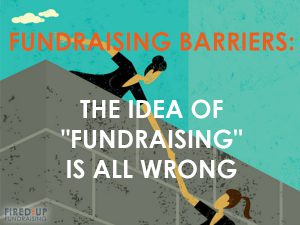 What are the fundraising barriers that are holding you back – even inside your own organization?
What are the fundraising barriers that are holding you back – even inside your own organization?
I bet there are plenty!
Are you and your team working, perhaps, within a whole sea of hindrances?
Many things happen inside nonprofits that don’t serve fundraising.
What’s more, some of this stuff actively works against your – and your organization’s – overall success. No kidding!
And I’ll tell you WHY all this happens, too.
Too many people think “fundraising” is distasteful.
They think it’s demeaning to those who do it, and a bother to those who receive it.
The problem is really with how people actually think about “fundraising.”
- It’s people’s personal attitudes that end up creating all sorts of fundraising barriers.
- It’s people’s personal attitudes that show up in your organization’s policies about fundraising.
- It’s their personal attitudes that show up in your nonprofit’s structure, decision making, internal budgeting and even your marketing.
The way we think about “fundraising” is all wrong!
Fundraising could actually be considered as an important, even noble activity.
It could be considered integral to your organization’s mission. Your donors could be considered one of your organization’s most valuable assets!
But no!
Because of people’s hidden, private attitudes, fundraising often gets relegated off into a corner – inside a silo.
Because people inside your organization think fundraising is yucky, your donors may be ignored. And we all know what happens then!
Here’s what happens when attitudes about “fundraising” are on the wrong track:
Fundraising barriers: People inside your organization won’t personally support fundraising.
When people make up nasty myths like fundraising is embarrassing and demeaning, then . . .
What kind of results does this attitude bring?
- You end up working with one hand tied behind your back. You don’t get cooperation from the rest of your organization.
- People don’t join in and take part in fundraising activites – instead they shy away.
- You’ll never really reach the potential revenue that’s really out there.
Fundraising barriers: Organizational structure — You are stuck in a silo.
This is when you and all your lovely fundraising initiatives are relegated into some isolated corner of your organization.
You work alone, without the cooperation, involvement and support of your colleagues.
You engage your donors by yourself. You sell your organization by yourself. You’re out there representing your organization all alone. It’s a lonely job.
What kind of results does this structure bring?
- Clearly your results are only a fraction of what could be accomplished if everybody in your organization was fully on board the fundraising train!
- When fundraisers are lonely, working with little interaction from others in the organization, productivity suffers.:(
Fundraising barriers: Fundraising goals are set in a vacuum.
Too many fundraisers tell me that their revenue goal was simply set from above by their CEO, executive team and/or board members.
You can’t just set a team’s goals for them with little or no input from the team itself. This is nothing but classic mismanagement.
What kind of results does this bring?
- When goals are set for a team without their input, then the team is not really bought into the goal. It’s more of a fiction than a reality.
- It’s demoralizing for fundraisers to have an impossible goal that they are not sure they can reach. When morale sags, then revenue results go down.
- There’s not a clear plan for even meeting the goal. With out a real plan with a timeline and strategies, the goal is simply fictional.
Fundraising barriers: Fundraising programs are not funded adequately.
When people inside your organization don’t really understand or support fundraising, then budgeting is often a struggle.
Why would decision-makers hire more fundraising staffers when they are not paying attention to the staff they already have?
What kind of results does this bring?
- Your organization ends up leaving so, so much money on the table.
- Because staffers are not paid, acknowledged or supported adequately, they only stay in their jobs less than two years. When they leave, the nonprofit’s fundraising takes a steep dive.
- Donors themselves, these lovely people who are making your work possible, are not cared for. They depart, taking their gifts with them.
BOTTOM LINE – THE SOLUTION:
It’s time to change the idea of what “fundraising” really is. (See my post The New Paradigm: From Fundraising to Philanthropy.”
It’s time for a culture shift! (See: Beyond Fundraising: What Does it Mean to Build a Culture of Philanthropy?)
When we do this, THEN we can start to get our entire organizations behind us.
THEN we can create that positive culture of philanthropy that supports everyone, and brings in so very much more money.
Next week, I’ll share some clear steps you can take to start building a true culture of philanthropy inside your organization.
What’s your experience like? I’d love to know!


